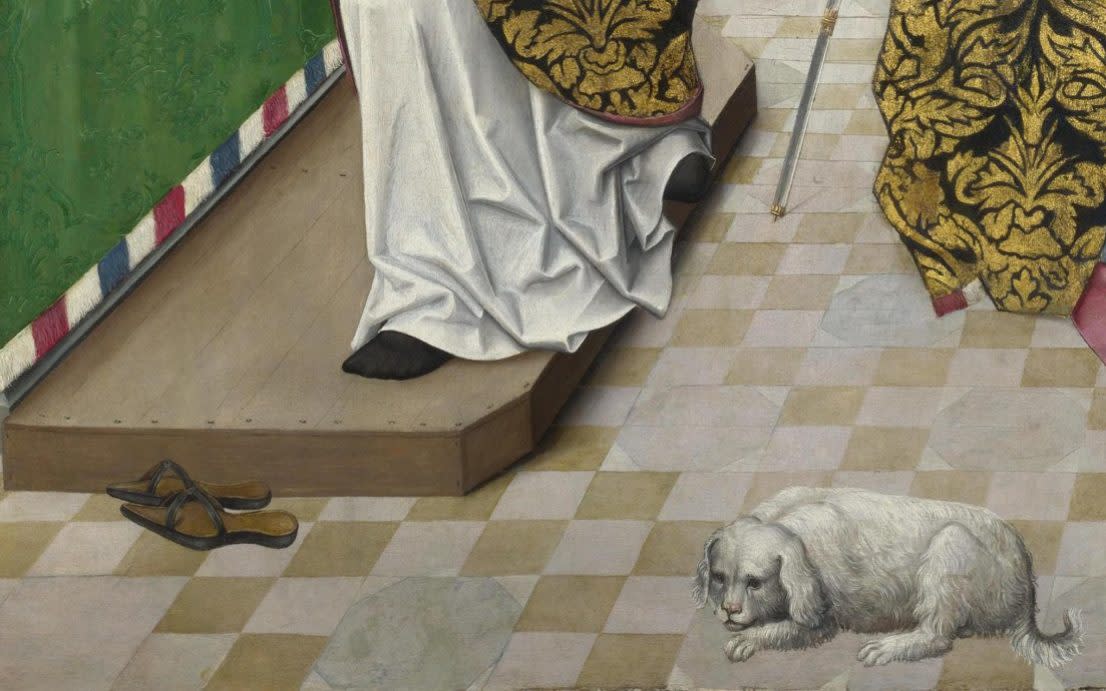Sacred Mysteries: What’s wrong with taking your dog to church?

More than half of England’s 42 cathedrals now admit dogs, my colleague Gabriella Swerling reported last week. They are not allowed to attend services “unless it’s a doggie service” and some adjoining cafes won’t let them in.
This is no modern trend, for old paintings show dogs in church as a matter of course. The National Gallery owns a late 15th-century painting of the Mass of St Hubert in which the saint, vested in liturgical gear, stands on a bare wooden foot pace, a step higher than the stone-paved floor, and wears what look like socks. Out of respect, his sandal-like shoes have been left beside the step on the floor, and there a dog lies, taking no notice of proceedings and unnoticed by deacon or laymen. The white dog is flat-faced, long-eared and shaggy.
Now, the Church Times has featured on its front page a black labrador called Daisy wearing a surplice and sitting in a choir stall. Her mistress, Sarah Morris, explains that she was asked to leave Winchester Cathedral when they went there, although the staff could not explain why the policy was to exclude dogs.
In response to a letter, the Dean of Winchester, the Very Rev Catherine Ogle, said she would try out a “new dog-friendly policy” for four months.
Miss Morris explained: “I am a single person, unmarried and without children. The person I love has four paws and a tail.” She goes on “dogrimage” with Daisy. “I felt that it was appropriate to have a little fun and draw attention to my pilgrimage by taking photos of Daisy as a Cathedral Dog chorister in each of the choir stalls we visited.”
Miss Morris points out that children can be noisy in church. At Ely Cathedral she came across a school party eating their packed lunch on the floor of the Lady Chapel. “Daisy did her labrador best, and attempted to clear up some of the sausage rolls and crisps.”
Both children and dogs came in for censure from Bishop Whitgift when he issued injunctions at Worcester in 1577. He called upon sextons to ensure that “in the time of public service or of sermons there be no walking, talking or crying of children, or fighting or brawling of dogs”. He didn’t envisage banning orderly children or dogs.
The third Archbishop of Canterbury after Whitgift, William Laud, in the 12 years before he was beheaded in 1645, favoured a measure which has been wrongly characterised as directed against dogs.
It is true that, as John Aubrey noted in his Brief Lives, Laud was “a great lover of cats”. In stained glass in the cloisters of Chester Cathedral he is depicted against the Canterbury Quadrangle of St John’s College, Oxford, of which he was President, with a cat by his side.
But his first ambition was to have the altar returned to the east end of the church, rather than keep the Holy Table in the nave. Altar rails would mark its sacredness.
His contemporary, Bishop Richard Montagu of Norwich, directed that the railings round the altar should be “close enough to keep out dogs from going in and profaning that holy place, from pissing against it, or worse’’. Laud was unsure of his legal power to enforce rails, but, dogs or no dogs, his chief focus was on the holiness of the altar.
Hauled before the Star Chamber in 1637 he bravely characterised the “Altar, as the greatest place of God’s Residence upon earth. (I say the greatest, yea greater then the Pulpit. For there ’tis Hoc est Corpus meum, This is my Body. But in the Pulpit, ’tis at most, but Hoc est Verbum meum, This is my Word.”


